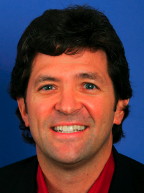May 11, 1996 Article Latest Between The Lines Article Higdon's Net Game /
Tennis Server
|

 |
At first, he was Gully. Like many people who met Tim Gullikson, I initially greeted him with his nickname--Gully--until I was certain I wasn't speaking to his twin brother Tom. It didn't take long, however, before our greetings were less formal and, admittedly, much more juvenile. They also were well-anticipated, since Gullikson was a rare breed on the tennis tour: Someone willing to take the time and energy to get to know everyone lucky enough to drift into his stratosphere. It wasn't an exclusive club. As evidenced by the scores of people who gathered on May 7 for "A Celebration of the Life of Timothy Ernest Gullikson" in Wheaton, Illinois, Gullikson's life more closely resembled the public parks atmosphere where he learned the game of tennis in Wisconsin than the private clubs preferred by many of his colleagues. Gullikson, who died on May 3 at age 44 after a struggle with brain cancer, touched many of us, from all walks of life. He once told me that the biggest difference between he and the countless other coaches on the pro tour was the fact that he always planned on being a tennis coach. It was not his "second" career after his playing skills diminished. He was born to coach. He couldn't help himself. I always avoided riding in the same golf cart with Gullikson because he wanted to help me with my swing, while I was only out there for the R&R. During one golf outing, I took a backswing on the seventh tee and suddenly was pelted in the face by a chunk of sod. Behind me, Gullikson was working on sports psychologist Jim Loehr's pitching technique, which obviously needed help. Loehr began to apologize, only to be drowned out by the sounds of Gullikson and Pete Sampras, the other member of our foursome, who were roaring with laughter. Sampras practically fell out of the cart clutching his side. During the funeral service, Dave Anderson, one of Gullikson's neighbors, told the gathering about a recent visit he had with Gullikson in the hospital. They were watching a match involving Sampras when the game's No. 1 player hit one of those screaming, running cross-court backhand passing shots that he seems to pull out of his bag of tricks every once in awhile. Gullikson stared at the screen and said, deadpan: "That kid has absolutely no natural talent. It's all coaching." Sampras was the perfect student for Gullikson. Suspicious but willing to listen, gifted yet still raw, Sampras was a Henri Leconte waiting to happen when they hooked up in 1992. Could Gullikson, an overachieving former pro who had reached a career-high ranking of No. 18 in 1978, provide the stimulus to turn a natural talent into a great champion? The answer was a definitive yes. When Tom Gullikson asked Sampras to bring a memento to the funeral, Sampras only had to look up at the cabinet in his living room to spot the perfect item: the 1993 Wimbledon trophy. Sampras spoke at the service, though he wasn't on the list of five people tapped to provide tributes. But after Loehr's touching talk, preceded by equally impressive yet sad reflections from Gullikson's 9-year-old daughter Megan, brother Tom and Tennis Magazine editor Donna Doherty, Sampras leaped from his seat and took the stand. After telling a story about Gullikson's aborted attempt to fast on one road trip, Sampras recalled his coach's trip to Las Vegas last year for the Davis Cup tie. "We would be surrounded by people, and all we had to do was look at each other and we would both smile and know..." At that point, Sampras broke into tears and was unable to continue. Believe me, he wasn't alone in his reaction. Nor was he the only person ever to feel the power of Gullikson's smile. Timmy never hesitated to flash his teeth and gums, and every time he did it felt special, a reminder that you were always a welcome member at his club.
Donations for the Tim & Tom Gullikson Foundation can be sent to 8000 Sears Tower, Chicago, IL 60606, telephone: 888-GULLIKSON. This foundation funds care and support programs for brain-tumor patients and their families.
1995 - May 1998 | August 1998 - 2002 | 2003 - 2007
This column is copyrighted by David Higdon, all rights reserved.
David Higdon was named a senior writer of Tennis Magazine (U.S.) beginning with the December 1994 issue, which featured David's cover story on Andre Agassi. David worked for the magazine since August 1988, when he was hired by the magazine as a senior editor. In September 1991, he left his full-time editing position with the magazine to become a contributing editor, moving from Connecticut to Portland, Oregon. He currently works as a freelance writer, writing regularly not only for Tennis but also for publications such as Sports Illustrated for Kids, The New York Times, Self, Boys' Life and USAir Magazine. He also serves as editor of Rip City Magazine, the official publication of the NBA's Portland Trail Blazers.
|



October 2022 Tennis Anyone: Patterns in Doubles by John Mills. September 2022 Tennis Anyone: Short Court by John Mills. |
 You will join 13,000 other subscribers in receiving news of updates to the Tennis Server along with monthly tennis tips from tennis pro Tom Veneziano.
You will join 13,000 other subscribers in receiving news of updates to the Tennis Server along with monthly tennis tips from tennis pro Tom Veneziano. 